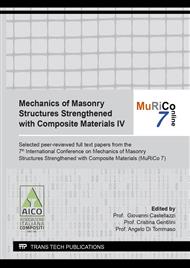[1]
G. Sarangapani, B. V. Venkatarama Reddy, and K. S. Jagadish, Brick-mortar bond and masonry compressive strength,, J. Mater. Civ. Eng., vol. 17, no. 2, p.229–237, (2005).
DOI: 10.1061/(asce)0899-1561(2005)17:2(229)
Google Scholar
[2]
M. B. Ravula and K. V. L. Subramaniam, Experimental investigation of compressive failure in masonry brick assemblages made with soft brick,, Mater. Struct. Constr., vol. 50, no. 1, p.1–11, 2017,.
DOI: 10.1617/s11527-016-0926-1
Google Scholar
[3]
G. Pruthvi Raj, M. B. Ravula, and K. V. L. Subramaniam, Failure in clay brick masonry with soft brick under compression: Experimental investigation and numerical simulation,, Key Eng. Mater., vol. 747 KEM, no. July, p.472–479, 2017,.
DOI: 10.4028/www.scientific.net/kem.747.472
Google Scholar
[4]
S. A. Hamoush, M. W. McGinley, P. Mlakar, D. Scott, and K. Murray, Out-of-Plane Strengthening of Masonry walls with Reinforced Composites,, J. Compos. Constr., vol. 5, no. 3, p.139–145, (2001).
DOI: 10.1061/(asce)1090-0268(2001)5:3(139)
Google Scholar
[5]
M. L. Albert, A. E. Elwi, and J. J. Roger Cheng, Strengthening of Unreinfired Masonry walls with FRPs,, J. Compos. Constr., vol. 5, no. 2, p.76–84, (2001).
DOI: 10.1061/(asce)1090-0268(2001)5:2(76)
Google Scholar
[6]
E. Hamed and O. Rabinovitch, Lateral out-of-plane strengthening of masonry walls with composite materials,, J. Compos. Constr., vol. 14, no. 4, p.376–387, 2010,.
DOI: 10.1061/(asce)cc.1943-5614.0000093
Google Scholar
[7]
T. D. Krevaikas and T. C. Triantafillou, Masonry confinement with fiber-reinforced polymers,, J. Compos. Constr., vol. 9, no. 2, p.128–135, 2005,.
DOI: 10.1061/(asce)1090-0268(2005)9:2(128)
Google Scholar
[8]
C. Faella, E. Martinelli, G. Camorani, M. A. Aiello, F. Micelli, and E. Nigro, Masonry columns confined by composite materials: Design formulae,, Compos. Part B Eng., vol. 42, no. 4, p.705–716, 2011,.
DOI: 10.1016/j.compositesb.2011.02.024
Google Scholar
[9]
C. Faella et al., Masonry columns confined by composite materials: Experimental investigation,, Compos. Part B Eng., vol. 42, no. 4, p.692–704, 2011,.
DOI: 10.1016/j.compositesb.2011.02.001
Google Scholar
[10]
G. Campione, L. La Mendola, A. Monaco, A. Valenza, and V. Fiore, Behavior in compression of concrete cylinders externally wrapped with basalt fibers,, Compos. Part B Eng., vol. 69, p.576–586, (2015).
DOI: 10.1016/j.compositesb.2014.10.008
Google Scholar
[11]
M. A. Silva and C. C. Rodrigues, Size and Relative Stiffness Effects on Compressive Failure of Concrete Columns Wrapped with Glass FRP,, J. Mater. Civ. Eng., vol. 18, no. 3, p.334–342, 2006,.
DOI: 10.1061/(asce)0899-1561(2006)18:3(334)
Google Scholar
[12]
J. Piekarczyk, W. Piekarczyk, and S. Blazewicz, Compression strength of concrete cylinders reinforced with carbon fiber laminate,, Constr. Build. Mater., vol. 25, no. 5, p.2365–2369, 2011,.
DOI: 10.1016/j.conbuildmat.2010.11.035
Google Scholar
[13]
A. Cascardi, F. Micelli, and M. A. Aiello, FRCM-confined masonry columns: experimental investigation on the effect of the inorganic matrix properties,, Constr. Build. Mater., vol. 186, no. September, p.811–825, 2018,.
DOI: 10.1016/j.conbuildmat.2018.08.020
Google Scholar
[14]
G. P. Lignola et al., Performance assessment of basalt FRCM for retrofit applications on masonry,, Composites Part B: Engineering, vol. 128. p.1–18, 2017,.
DOI: 10.1016/j.compositesb.2017.05.003
Google Scholar
[15]
L. Garmendia, P. Larrinaga, R. San-Mateos, and J. T. San-José, Strengthening masonry vaults with organic and inorganic composites: An experimental approach,, Mater. Des., vol. 85, p.102–114, 2015,.
DOI: 10.1016/j.matdes.2015.06.150
Google Scholar
[16]
IS 3495:Parts 1-4 Methods of Tests of Burnt Clay building brick. 1992, p.1–7.
Google Scholar
[17]
M. B. Ravula and K. V. L. Subramaniam, Cohesive-frictional interface fracture behavior in soft-brick masonry: experimental investigation and theoretical development,, Mater. Struct. Constr., vol. 52, no. 2, p.1–12, 2019,.
DOI: 10.1617/s11527-019-1333-1
Google Scholar


